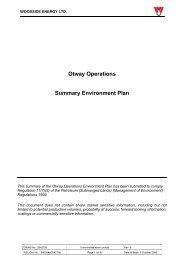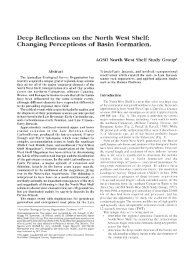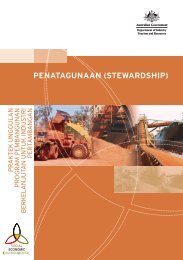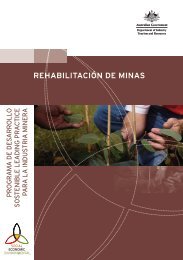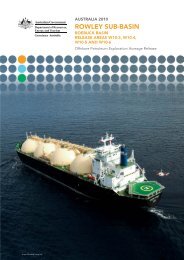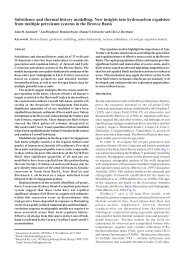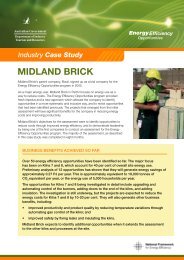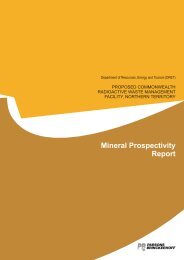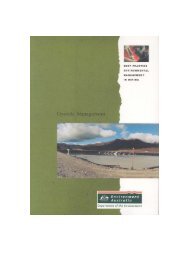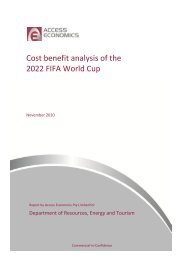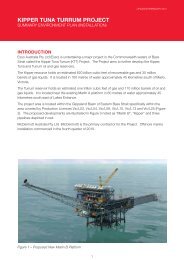A guide to leading practice sustainable development in mining
A guide to leading practice sustainable development in mining
A guide to leading practice sustainable development in mining
Create successful ePaper yourself
Turn your PDF publications into a flip-book with our unique Google optimized e-Paper software.
Secondary impacts such as changes <strong>in</strong> graz<strong>in</strong>g patterns and the <strong>in</strong>troduction or<br />
<strong>in</strong>creases <strong>in</strong> weeds and feral fauna should be addressed by the <strong>development</strong> and<br />
implementation of land management plans. Identification and control of problem<br />
weeds, <strong>in</strong>clud<strong>in</strong>g the prevention of <strong>in</strong>troduction <strong>in</strong> and adjacent <strong>to</strong> operat<strong>in</strong>g<br />
areas, should be carried out. Where feral fauna such as the fox, cat, pig or goat are<br />
negatively impact<strong>in</strong>g conservation values, their numbers should be moni<strong>to</strong>red and if<br />
necessary, control methods implemented.<br />
Lead<strong>in</strong>g <strong>practice</strong> biodiversity management goes beyond m<strong>in</strong>imis<strong>in</strong>g long-term<br />
impacts from operations. It identifies opportunities for improvement <strong>in</strong> the lease and<br />
adjacent areas by <strong>in</strong>troduc<strong>in</strong>g <strong>in</strong>novative and <strong>susta<strong>in</strong>able</strong> land management <strong>practice</strong>s<br />
and/or controll<strong>in</strong>g weeds and feral fauna <strong>to</strong> the greatest practicable extent. These<br />
<strong>in</strong>itiatives may be undertaken by the companies themselves, or <strong>in</strong> partnership with<br />
government and NGOs.<br />
Manag<strong>in</strong>g impacts on aquatic fauna<br />
Aquatic ecosystems occupy low-ly<strong>in</strong>g parts of the landscape and will, therefore, be<br />
the ultimate recipients of runoff from m<strong>in</strong><strong>in</strong>g activities. The l<strong>in</strong>kages between the<br />
quality of terrestrial ecosystem management and receiv<strong>in</strong>g aquatic ecosystems are<br />
typically very strong. It is therefore difficult <strong>to</strong> achieve good outcomes from plann<strong>in</strong>g<br />
management of aquatic ecosystems without due consideration of these l<strong>in</strong>kages.<br />
M<strong>in</strong><strong>in</strong>g impacts on aquatic ecosystems arise from four sources:<br />
water quantity issues<br />
water quality issues<br />
habitat structure issues and<br />
organism passage issues.<br />
Alterations of the surface runoff and/or groundwater flow characteristics and<br />
pathways can affect water quantity. M<strong>in</strong>ed landscapes can differ greatly <strong>in</strong> ra<strong>in</strong>fallrunoff<br />
relationships from the orig<strong>in</strong>al landscape. Rehabilitated landscapes will<br />
commonly have altered <strong>to</strong>pography from the orig<strong>in</strong>al landform, result<strong>in</strong>g <strong>in</strong> changes<br />
<strong>to</strong> the directions, quantities and tim<strong>in</strong>g of surface flows.<br />
Furthermore, m<strong>in</strong>es often <strong>in</strong>tercept or use aquifers. The geological layers m<strong>in</strong>ed may<br />
themselves be important aquifers support<strong>in</strong>g groundwater dependent ecosystems.<br />
In the arid and semi-arid regions that host much of the Australian m<strong>in</strong><strong>in</strong>g <strong>in</strong>dustry,<br />
ground waters are commonly key resources used by m<strong>in</strong><strong>in</strong>g companies. The impacts<br />
on these ecosystems dur<strong>in</strong>g and post operation need <strong>to</strong> be unders<strong>to</strong>od as do<br />
mechanisms for their ma<strong>in</strong>tenance and rehabilitation.<br />
The ANZECC/ARMCANZ (2000) Water Quality Guidel<strong>in</strong>es summarised <strong>in</strong> Batley et<br />
al. (2003) <strong>to</strong>gether with associated state and terri<strong>to</strong>ry legislation, constitute a water<br />
quality risk-management framework for management of biodiversity <strong>in</strong> aquatic<br />
ecosystems. Lead<strong>in</strong>g <strong>practice</strong> management of water quality impacts follows the<br />
risk-management framework of the <strong>guide</strong>l<strong>in</strong>es. It should also ensure the moni<strong>to</strong>r<strong>in</strong>g<br />
program sensitivity can detect trends <strong>in</strong> water quality parameters while the<br />
measurements rema<strong>in</strong> below the water quality objectives. This allows management<br />
steps <strong>to</strong> be implemented before a decl<strong>in</strong><strong>in</strong>g trend of water quality can lead <strong>to</strong><br />
biodiversity impacts.<br />
A GUIDE TO LEADING PRACTICE SUSTAINABLE DEVELOPMENT IN MINING 93






